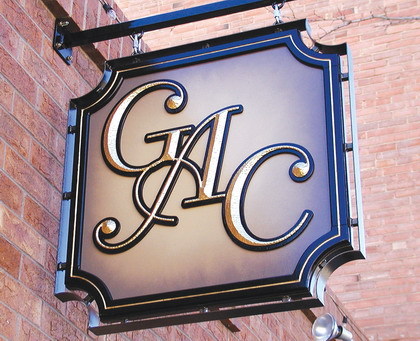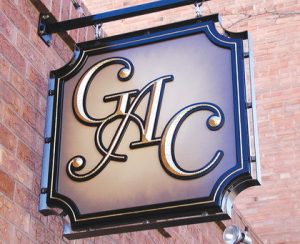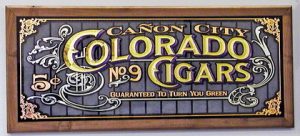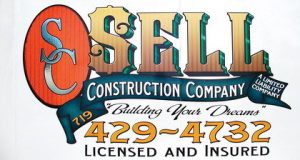Dimensional Signs
Entering the Third Dimension
Bill DeBekker recounts his shop
Published
16 years agoon

In the eyes of some (probably signshop owners in urban areas who see greener grass), small-town signmakers enjoy an easy racket. Ostensibly, competition is less keen, and clients’ rustic inclination creates a deep reservoir of patience and appreciation for the signmaking craft.
“Bogus,” according to Bill DeBekker, proprietor of the Third Dimension Sign Co. (Canon City, CO). Although many local customers appreciate his talents and grant him his desired autonomy, DeBekker must still contend with backseat-driver customers and need-it-yesterday deadlines. Moreover, amidst a lingering economic downturn in a town largely dependent on tourism, he must increasingly ply his trade with utilitarian signage that pays the bills rather than stoke his creative juices.
How’d I get here?
DeBekker was born in NYC, and although his family moved to Canon City at age six, he said he never lost that “Big Apple” mentality: “I may have lost the accent, but never the attitude. I still believe in accomplishing tasks in an efficient and thorough manner.”
His ambitions steered him to Phoenix and a professional modelmaking career, for which he frequently traveled to Los Angeles to design and paint model aircraft, boats and spaceships. His portfolio includes several prototypes he developed for Estes, a model-rocket purveyor, that were ultimately used in Star Wars Episode I: The Phantom Menace.
AdvertisementDeBekker returned to his childhood home, and his sign career happened “by accident” – he walked into a signshop, looking for painting work, and ended up with a new job.
“This was a radical departure for me,” DeBekker said. “Even in the early ’90s, signmaking had already become highly automated, but I had no idea this technology could be used to make signage.”
After his indoctrination, he partnered with this signmaker and founded Rush Signs in 1995. Although DeBekker received some instruction from K.C. Evans, a veteran local signpainter, personal trail-and-error comprised most of professional development.
“Probably the best advice [K.C.] gave me was to purchase [Mike Stevens’ book] Mastering Layout,” he said. That book and Signs of the Times were the most valuable resources in developing my signmaking career.”
Mastering his market
As often happens with partnerships, DeBekker and his former associate severed ties somewhat acrimoniously in 2001. After having taken time to marshal sufficient resources and capacity, he opened Third Dimension the following year.
AdvertisementPresently, dimensional signage comprises approximately half of the shop’s work; plotter-cut vehicle graphics comprise a quarter of the workload. DeBekker said that, because of the sizeable profit margin they generate, he would devote his shop entirely to vehicle graphics if his market could sustain such demand.
With a population of approximately 22,000, Canon City is home to the Royal Gorge Bridge, a National Historic Register site. Its tourist-oriented downtown offers an historic backdrop where building-mounted or hanging, 3-D signage represents the norm.
“These signs will last until these stores change hands or the owner decides he or she wants to rebrand, a five- to eight-year span,” DeBekker said. “In a town this size, that doesn’t bring about a lot of repeat work, even though I operate the only full-service shop in town.”
Canon City and its environs have become an epicenter for a somewhat grisly industry – correctional facilities. According to DeBekker, the area hosts more federal and state correctional facilities per capita than anywhere in the nation. These facilities include the Florence Supermax ultra-high-security facility that houses such notorious criminals as “Unabomber” Ted Kaczynski and mob informant Sammy “the Bull” Gravano. Most of his prison-industry trade sifts through indirectly – guards and other staff commonly hire him to print graphics to decorate the hotrods they race or build recreationally.
DeBekker’s work has grown increasingly into Colorado Springs, Pueblo and other nearby cities. To date, the farthest he’s traveled for a job was nearly 500 miles to Casper, WY. However, the result translated into caveat venditor (let the seller beware) for DeBekker.
Advertisement“The client insisted we use a flat color scheme and forbade airbrushed highlights, which made the sign seem monochromatic,” he said. “Then, when I got there, the condition of the building’s exterior walls made installation challenging and time-consuming. In the end, I regretted taking this job.”
Though people might think stereotypical Western independence would translate into laissez-faire sign codes, this unfortunately isn’t the case. Canon City’s sign codes prohibit all electronic message boards, and all downtown signs must measure less than 32 sq. ft., and must not exceed 25 ft. above street level.
Despite the occasional occupational frustrations, signage continues to fuel his creative passion. For inspiration, he often refers to packaging and fruit-crate designs and cigar labels from the early 20th Century (see ST, April 2007, page 82). In stark contrast to the current, widespread emphasis on minimalist, “clean” design, DeBekker embraces and emulates the vibrant, interwoven elements these bygone advertisements convey.
“I’m not a fan of abstract, modern art,” he said. “I think signs, like any other form of visual communication, should engage the viewer.”
In the shop
Third Dimension occupies approximately 25,000 sq. ft. of space that includes three buildings that measure roughly 8,000 sq. ft. apiece – one houses the shop’s routing and welding equipment; one shelters its printer and related digital accessories, and a third stores its other materials.
To craft its dimensional signs, DeBekker and his three-person team uses a 4 x 8-ft. Shopbot router, which he outfits with Onsrud Cutter carbide blades. Though he’s well aware of faster cutting speeds, taller gantries and additional amenities provided by new-generation, CNC routers offered by MultiCam Inc., AXYZ Intl. and other manufacturers, DeBekker said his 10-year-old machine meets his needs.
One vestige of his modelmaking days has enhanced his signmaking career. In lieu of standard, 3-D sign software, DeBekker uses Rhino, a 3-D, modeling software that allows him to create intricate detail. Though Rhino is designed for model routers, which operate on more axes and with deeper gantries than their signmaking counterparts, he said the program is readily compatible for signmaking.
“When we have to rout signs deeper than 3 in., we just cut separate pieces and bond them together,” DeBekker said. “But, that’s only been necessary a handful of times.”
For designing flat graphics and standard, prismatic letters, his team uses CADlink’s Signlab® version 7.1. Unlike many signmakers, DeBekker doesn’t begin his process with manual sketches. “Even though I can visualize designs, I can’t even draw good stick figures.”
Coming full circle, DeBekker has resumed fabricating molds. Third Dimension employs a sculptor who fashions caricatures or appliqués from polyurethane resin, HDU or cold-cast bronze. He’s producing a 4-ft.-wide, bronze-cast medal for a ceremony conducted by the Distinguished Flying Cross Society, which honors military aviators who’ve performed heroic deeds.
Recently, he outfit his routing shop with state-of-the-art, automated, metal-forming equipment, with which he’s begun fabricating LED-lit electric signage. DeBekker attributes this growing market to the energy savings and the sharp reduction in prices, especially for white LEDs.
DeBekker’s well aware that his path into the sign industry represents the road not ordinarily taken, but his advice to new signmakers should resonate universally: “Appreciate and learn from others’ styles, but develop your own. And, rather than chasing a quick buck, really learn your craft and take pride in what you do. That’s the only way anyone can derive true satisfaction from their work. Self-employment isn’t a job; it’s a lifestyle.”

SPONSORED VIDEO
Introducing the Sign Industry Podcast
The Sign Industry Podcast is a platform for every sign person out there — from the old-timers who bent neon and hand-lettered boats to those venturing into new technologies — we want to get their stories out for everyone to hear. Come join us and listen to stories, learn tricks or techniques, and get insights of what’s to come. We are the world’s second oldest profession. The folks who started the world’s oldest profession needed a sign.
You may like

PRINTING United Alliance Forms Strategic Partnership with ASI

The Joy of Working

5 Signs That Embody Care and Gratitude
Subscribe

Bulletins
Get the most important news and business ideas from Signs of the Times magazine's news bulletin.
Most Popular
-

 Photo Gallery1 week ago
Photo Gallery1 week ago30 Snapshots of the 2024 ISA Sign Expo
-

 Ask Signs of the Times2 weeks ago
Ask Signs of the Times2 weeks agoWhy Are Signs from Canva so Overloaded and Similar?
-

 Paula Fargo6 days ago
Paula Fargo6 days ago5 Reasons to Sell a Sign Company Plus 6 Options
-

 Real Deal3 days ago
Real Deal3 days agoA Woman Sign Company Owner Confronts a Sexist Wholesaler
-

 Benchmarks2 weeks ago
Benchmarks2 weeks ago6 Sports Venue Signs Deserving a Standing Ovation
-

 Photo Gallery6 days ago
Photo Gallery6 days ago21 Larry Albright Plasma Globes, Crackle Tubes and More
-

 Women in Signs2 weeks ago
Women in Signs2 weeks ago2024 Women in Signs: Brandi Pulliam Blanton
-

 Women in Signs1 week ago
Women in Signs1 week ago2024 Women in Signs: Alicia Brothers














